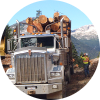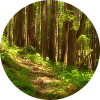Bella Coola is situated in the transition from the wet coastal rainforest to the drier continental (interior) forests and the topography is highly mountainous. Therefore, the ecology is very diverse. Much of the land base is inaccessible for resource development and so most of the area remains unaltered; however, the forests in the valley bottoms and lower elevations in many of the larger watersheds have been partially logged during the previous 100 years.
The Bella Coola Community Forest is primarily situated in the Bella Coola valley and encompasses the Nusatsum, Salloompt, Tseapsehoolz, Noosgulch, Cacoohtin, Noomst, and portions of the Talchacko tributary valleys. In addition, the Clayton Falls and Nooseseck valleys and adjacent shorelines in North Bentinck are also included along with a portion of the Kwatna Peninsula in Burke Channel (See map page). With the moist and warm growing conditions, the forest land is productive and on average will produce 3.4 m3 of wood per hectare per year.
The total area of the Community Forest is quite large at 128,660 ha; however, given the mountainous terrain, most of the area (81%) is non-forested, ice, rock and alpine. Only 24,270 ha is forested and of that, only 9,270 ha is considered as the Timber Harvesting Landbase (THLB).
Area Summary
| Area | size | portion |
|---|---|---|
| Total Area | 128,660 ha | 100% |
| Non-forest – alpine, rock, ice | 104,390 ha | 81% |
| Constrained forest – un-accessible, habitat reserves, low quality timber | 15,000 ha | 12% |
| Timber harvest land | 9, 270 ha | 7% |
With such a small operating land base, the impact of forest harvesting is relatively low, especially since THLB is harvested over a time frame equivalent to tree rotation (80 to 100 years). So, in any particular year, roughly 1% of the timber harvest land would be logged, which equates to 0.3% of the total forest area and <0.1% of the total area of the licence.



